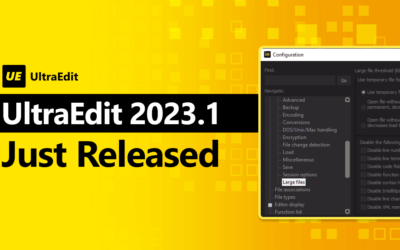There are hundreds of programming languages out there, and each one has its own unique syntax and conventions. As a software developer, it can be difficult to know how to edit source code of a software program written in a different language. This is where applications like source code editors that do syntax highlighting of the code come in handy.
You may find many versions of different source code editors on the market. Each code editing software has its own advantages and disadvantages. Today, we will be discussing one of the most popular code editors, UltraEdit. We will show you how to edit source code of a software, and we will also provide some tips on working with source code files.
Source code files are composed of lines of text that are divided into individual instructions. When you’re editing the code base, it’s important to keep track of the different elements that make up a line of code.
Most of the time, source code is not shipped with any software programs. Instead, it is typically compiled into binary executable files that can be run on a computer.
When you edit binary executables, you are actually changing the compiled form of the code. This can be a little more challenging than editing compiled code, because you need to be aware of the different types of terminators that are used in different programming languages. In this case, a hex editor like UltraEdit can be very helpful.
However, if the software source code is available, then you can usually edit it with a standard text editor. In general, source code editors are very versatile tools that can be used for a variety of tasks, such as editing code, creating project files, and debugging software programs.
How Can I Edit Source Code of a Software Program?
As mentioned, code editor is a piece of software that allows you to write and edit source code. Source code is the written instructions that tell a computer how to run a program.
Some code editors also include a source code management system (SCM), which allows you to manage your source code files and version control it. Also, smart completions, code navigation, and error detection and correction features are common features of code editors.
There are a number of ways to edit source code of a software program. The most common way is to use a standard text editor, such as Notepad. However, some source code editors, such as UltraEdit, come with built-in support for many different programming languages.
Syntax highlighting is also a common feature of many source code editors. This means that the editor will color-code different parts of the code based on the syntax rules that are used in that particular language. This can make it easier to understand the code, and it can also help you find syntax errors and typos.
With different syntax highlighting and error-detection features, source code editors can also be used for debugging software programs. This is especially useful if you are not familiar with the code base that you are working on.
Step 1: Choose a Source Code Editor
When you have a source code, you will need to choose a source code editor program to edit it. Then, you will need to decide which programming language you want to use.
Find whether the source code editor is compatible with the programming language you want to use. A multi-language editor will support many different programming languages.
Step 2: Make Sure You Have the Rights to Edit the Code
Before you can start editing the source code, you will need to make sure that you have the rights to publish any changes you may make. Source license agreements and copyright laws can vary from country to country, so it is important to check with the copyright holder before you start editing the source code otherwise you may be wasting your time making edits on source code that you are not able to distribute (if that is your goal). Some source code licenses allow you to make changes to source code if you don’t distribute the changes.
Step 3: Load the Source Code into the Editor
Once you have chosen a source code editor and have confirmed that it is compatible with the programming language you want to use, you can start loading the source code into the editor. If you do not have the source code you might need a hex editor to edit the program if it is in a binary format.
Step 4: Edit the Source Code
Once you have loaded the source code into the editor, you can start editing it. Using your chosen source code editor, you can edit the source code to fix errors, add new functionality, or change the layout of the code.
Step 5: Save the Source Code
After you have finished editing the source code, you will need to save it. You can do this in a number of different ways, depending on the editor that you are using.
Some programming editors will allow you to save the source code in a variety of different formats, such as plain text, XML, or JSON.
What Can Code Editor Applications Do?
Plain text editors are used to edit source code of software applications, but they can also do other things like managing hundreds of files, creating and editing text documents, and so on.
Code editor applications can do a number of different things. Function definitions, class definitions, and method definitions are all common targets for code editor applications. Code editor applications can also be used to modify source code. This can include adding or removing code, changing the order of code, and modifying code syntax.
A powerful source code editor application can also be used to debug code. This can include finding and fixing errors in code, as well as finding and resolving dependencies between code modules.
In addition, code editor applications can be used to create custom code templates. This can include creating boilerplate code for common tasks, or creating custom code for specific purposes.
User-defined syntax highlighting and code analysis are what usually distinguishes a good code editor application from a poor one. An excellent code editor application is equipped with a wide variety of advanced features that can help developers write code more efficiently and effectively.
Some of the key features that a code editor may offer include:
-
- Project support feature
- Smart autocompletion and function completion
- Integrated development environment
- Easy-to-use interface and file manager
- Built-in package manager
- Interactive console
- Unicode compatibility
- Cloud service or integration
Some open-source software text editors are available but a lot of code editors are proprietary or part of them is proprietary.
Do You Need a Code Editor?
Code readability and maintainability are important factors in software development. Advanced programming features can be useful, but they can also obscure the code and make it more difficult to understand.
A code editor can help you write clear, concise code by providing a variety of features to help you organize your thoughts and work on the code simultaneously. While programming skills are important, a code editor can also help you avoid common coding mistakes.
Millions of developers use code editors every day. From markup languages like HTML and CSS to more complex languages like Java and Python, code editors are essential for developers of all levels.
Code templates and snippets make it easy to get started, and many code editors include integrated desktop environment features like version control and debugging. But what is the best text editor for you?
UltraEdit is a full-featured, cross-platform code editor that brings out the best in your programming skills, making your development process more efficient and productive.
Whether you are working with a single file or a large programming project, UltraEdit may be the perfect code editor for you.






0 Comments